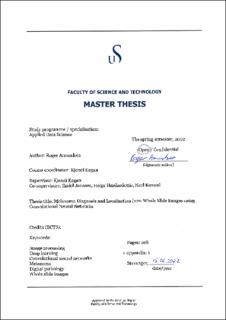| dc.description.abstract | During the last decade, no other cancer type in Norway have had higher
increase in incidents than skin cancer. Melanoma is the most aggressive type
of skin cancer because it has the ability to rapidly spread, which makes early
diagnosis important. By conventional methods, melanoma diagnosis involves
examination of melanocytic lesions under a light microscope performed by a
pathologist. The diagnosis is both time and labor intensive, subjective and
not always easy to reproduce. The increase in incidents means even more
workload on the pathology departments, and increased waiting time for the
patients.
Digital pathology is a subfield of pathology that has emerged due to the
ability to scan histology glass slides into digital whole slide images (WSI).
This opens for computational analysis typically using image processing and
deep learning. In this thesis a method is proposed to 1) automatically classify
WSIs as either melanoma or benign nevus using image processing and
convolutional neural network, and 2) localize the lesions and display them in
overview images to aid the pathologist and add confidence to 1).
The dataset consists of 93 WSIs from Stavanger University Hospital. All
have been provided slide-based diagnosis labels, and regions of interest have
been annotated by a pathologist. Due to the giga-pixel size of the WSIs they
had to be split into patches, and the patch-based labels correspond to the
annotations.
A pre-trained VGG16 network was fine-tuned on 215320 patches from
benign lesions, 215320 from malignant lesions, and 16806 from other normal
tissue types combined into one class. The proposed inference pipeline is
to predict all patches of an unseen WSI based on the trained VGG16 and
thresholding, create an overview image with the predictions, and provide
a slide-based prediction based on the ratio of malignant- to benign lesion
pixels.
The 5 benign nevus and 4 melanoma WSIs of the unseen test set were all
predicted with the correct slide-based label. The overview images correctly
localized 83.78 and 93.54 % of the benign and malignant lesions, respectively. | |
